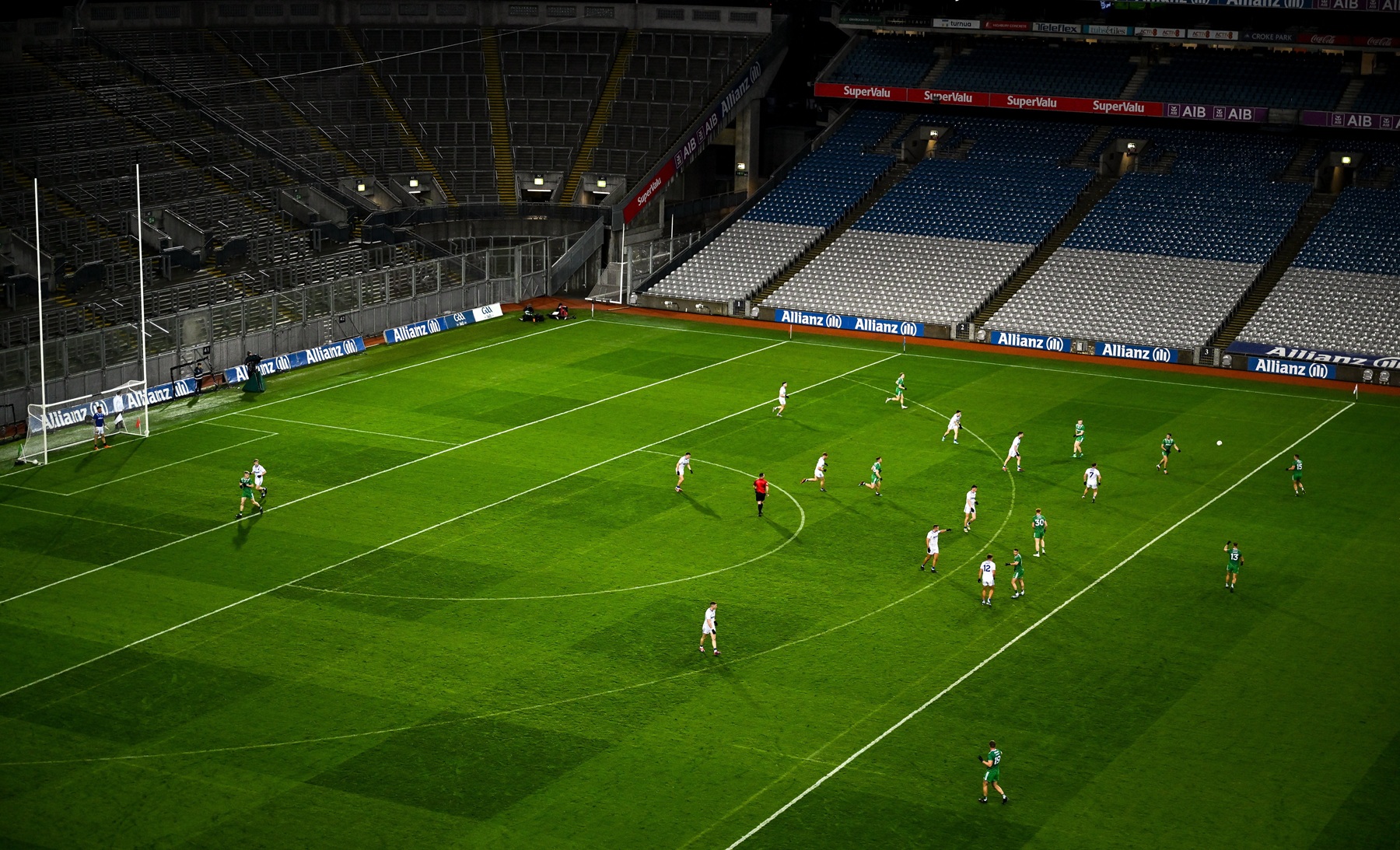With the new rule enhancements, Gaelic football has been transformed into a more entertaining game. One of the increases has been in the variations in movment and runs. Michael McMullan takes a look…
THE game of Gaelic football has changed overnight with Jim Gavin and his Football Review Committee (FRC) rolling out a series of enhancements.
With many games lacking entertainment due to possession of the ball being so important that very few rewards were with the risk.
GAA President Jarlath Burns said enough was enough and Gavin’s men were sent to work.
There have been tweaks since but we now have a game where it is chaos where champions thrive. There is still an element of keep ball, but there is enough space for the adventurous teams to work their magic.
As part of the changes, a Games Intelligence Unit (GUI), partnered with Dublin City University, to delve into what Gaelic football now looks like.
One of the key factors inter-county managers have been saying is the level of work players get through during a game. There were appeals for more substitutes to be made available.
In conjunction with the GUI’s findings and the GPS data from four inter-county senior panels, here is a look at the difference between playing in 2024 and 2025, based on data gathering from the provincial championships.
The study has a player’s movement divided up between six actions: standing, walking, jogging, running, high-intensity running.
Goalkeeper
THIS time last season, we had goalkeepers who were all over the place. They had total freedom until they had their licence recalled. They are largely redundant in their own half and can only take possession on the other side of halfway of their team pays back a middle third player.
Goalkeepers in the 2025 provincial championships have a combined increase of 160 instances walking or standing during a game.
In terms of high intensity runs, there was a 33 per cent reduction. While a goalkeeper sprinted on average once per game last year, that figure dropped to zero for 2025.
The finding would suggest a new focus for managers when it comes to selecting a goalkeeper.
Unless there is a goalkeeper with experience of playing outfield, there may not be the same focus on converting them into a goalkeeper on the overlap.
Also, with more twice as many goals scored in the All-Ireland SFC Round One this year compared to 2024, goalkeeper coaches may decide to work more on the core components of goalkeeping – mid to long range kicks, controlling the penalty area and saving shots.
Full-back line
OVER the last decade a last line defender nearly always had the protection of sweepers and plus ones. In some cases, teams doubled down on them. To counteract that, with teams playing with a forward less, forward-thinking managers began to play with a defender who would attack.
Now, everything has changed back with the FRC ruling that teams must have three players in each half of the field. In some cases, that has been rotated but it’s largely the same three players back.
Like goalkeepers, there is more standing and walking on average than last season but80 instances this time but that’s to be expected. There is more concentration needed with less space and much of the marking in the inside defensive line is about positioning and body shape.
The surprising statistic is that high intensity running and sprinting are much the same. Reflecting on the role close to goal, rather than hard running to support an attack, there is more running in different directions to track forwards who have more license to take players on.
Going forward, from a coaching point of view, one on one tackling will be the key skill with less cover. The better defenders will be able to jog around to get goal side of their player and conserve their sprints for supporting a fellow player boxed in by the press with the option of passing back to the goalkeeper not an option any more.
Half-back line
AS we move into the middle third, the most bizarre statistic of more walking instances in 2025 than the previous season. It’s only a four-county sample but you may possibly feel the reason for that comes around from teams getting in positions for the middle third press and flooding the middle.
In terms of running numbers for the half backs, there is more jogging and running which also points to a pattern of getting players into a position to protect the arc to guard against the two-point score.
Half backs have almost the same average number of high-intensity runs, 56 and 55 while the average remains the same for sprints.
While no study would be unable to give a reading of distances covered, the pace of the runs and how many times middle third players are swapping into the into a three versus three role for a breather, this is the avenue for conserving energy.
There is also consideration needed around teams’ styles of play. From this survey, the identity of the counties involved were not made known. With the ball travelling faster than any player, an advancement of a kicking game could also change the distance covered.
Midfield
NOW to the hub. The player in the eight and nine jerseys are the box-to-box players. Always have and always will be.
From the 2024 provincial championships until now, the average midfield has an average 61 instances of jogging and running. That’s what we’d have expected.
High intensity remains at 49 on average per game with sprinting marginally down to eight. There is more walking as well but more variation on the different aspects of movement.
From watching games, midfielders can often be seen dropping back for a spell to pick up an imposing inside forward or even going the other way to play at full-forward. Ryan McEvoy is an example of this.
As counties begin to plan for the 2026 season, after the dust has settled, managers may well give their conditioning coaches the brief of increasing the number of high-intensity runs.
Breaking lines and getting back to help teams crack the problem with using the short kick-out may come into the debate. It will also be a plan that may include four midfielders. Two for the first 40 minutes with a couple more to come in. That’s where the work level is at the minute.
Half-forward line
THE half forward area is a carbon copy of midfield as regards the GUI survey results from year to year.
The numbers are still the highest of anybody in the team for the hardest yards. Both 2024 and 205 give figures of 59 and 58 for the high-intensity runs. Think of a game lasting 70 minutes and that’s a savage level of work. Throw in 12 sprints.
From a footballing point of view, the half forwards are the players breaking lines for the backdoor cut to either get in behind a defence of support the ball kicked to the inside line. Think of the penalty Kerry won against Armagh in the league game in Tralee. The runs of Shane O’Donnell in the dying embers of extra-time to brother Niall’s winner. Darragh McMullen epitomises this role.
While the numbers haven’t changed in a year, for the most intense runs, the main takeaway point is the need for impact. Teams who are successful have finishers and these numbers tell you why half forwards are often the players replaced.
They also tell why extra-time is a bridge too far in the new rules. It comes down to who cramps less or runs out of subs quicker.
Full-forward line
LIKE the full-back zone, the inside forwards – and goalkeepers – are where the difference is from 2024 to 2025. The inside forward makes more high-intensity runs, 49. The same as a midfielder. Only the half backs make more but their figure was the same in 2024.
The three on three the room it creates allows forwards to take on a defender when they can see green grass. No longer is recycling the first option or sitting wide to peel around on the loop to kick a point.
When counties spend the winter thinking of ways to coach one on one defending, it’s the same for coaching forwards to take players on. The teams who will benefit are those with the crisp basic skills and a conditioning coach who can make players more explosive. Ask any defender what they hate – pace and it coming direct.
A scoring increase
THERE have been fewer goals in this season’s provincial championships but over twice as many in the opening round of the All-Ireland SFC group stages since last season.
There has been the expected overall rise in scoring with the inception of the new rules.
The biggest difference has been in Ulster where last year’s tally of 17 dropped to 10, albeit three games in 2024 went to extra-time with this season’s final the only game with the result needing more than the 70 minutes to find a winner.
As expected, with the introduction of the new rule for the two-point score, the point tallies have been higher.
Kerry and Louth have scored the most goals. Kerry bagged 10 of their overall tally of 27 goals for the season coming in their two Munster games and recent victory over Monaghan.
David Clifford and Paul Geaney have each scored six goals for the Kingdom this season, with Clifford rested for the first two league games.
Leinster champions Louth scored six championship goals in their four games on the way to ending a 68-year famine with another four coming against Monaghan last weekend.
Sam Mulroy with 4-68 has been the main score for the Wee County across their memorable season to date.
The top scorer in Ulster so far is Down’s Pat Havern with 0-81 (30f, 10 tp, 8 tpf) to his name.
2024 championships
2650 minutes, including three games going to extra time.
Ulster: 17-226
Munster: 11-131
Leinster: 14-178
Connacht: 11-164
All-Ireland Qualifier Round 1: 11-229
2024 Total: 64-928
2025 championships
2650 minutes, including three games going to extra time.
Ulster: 10-357
Munster: 13-198
Leinster: 11-225
Connacht: 12-231
All-Ireland Qualifier Round 1: 24-272
2025 Total: 70-1283
Receive quality journalism wherever you are, on any device. Keep up to date from the comfort of your own home with a digital subscription.
Any time | Any place | Anywhere














